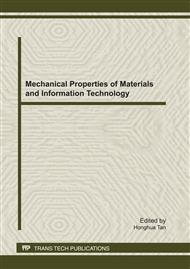p.402
p.409
p.416
p.421
p.429
p.436
p.439
p.444
p.451
Research on Strengthening Decomposition of Organic Nitrogen by Ammonibacteria in the Faber Cymbidium Plant Floating Island
Abstract:
Owing to the characteristics of the effluent with high concentration of ammonia nitrogen and low removal rate in the most artificial plants floating islands, two strains A1, A2 with high-efficiency ammonification screened from the laboratory were selected to use for enhancing decomposition capability of organic nitrogen in the plants floating island in order to improve nitrogen removal. The result showed that the decomposition rate of organic nitrogen by strains A1, A2 were 81.80% and 72.68% respectively, at the same time, decomposition equation was in line with zero order degradation reaction. Moreover, decomposition rates were VA1=0.8310mg/L•h and VA2=0.7619mg/L•h. The simulated ecosystem of sewage treatment was constructed by faber cymbidium (evergreen plant) plant floating island, and then the decomposition reaction of organic nitrogen met first-order kinetic equation in which k was 0.0752. If the strain was put into the previous simulated ecosystem, hydraulic retention time was shortened greatly and the degradation speed of ammonia nitrogen could be accelerated by cooperating action between amonifying bacteria and plant floating island. Furthermore, the ammonia nitrogen of the effluent could meet first discharge demand of integrated wastewater discharge standard (GB8978-1996) after 48h.
Info:
Periodical:
Pages:
429-435
Citation:
Online since:
September 2011
Authors:
Price:
Сopyright:
© 2012 Trans Tech Publications Ltd. All Rights Reserved
Share:
Citation:


